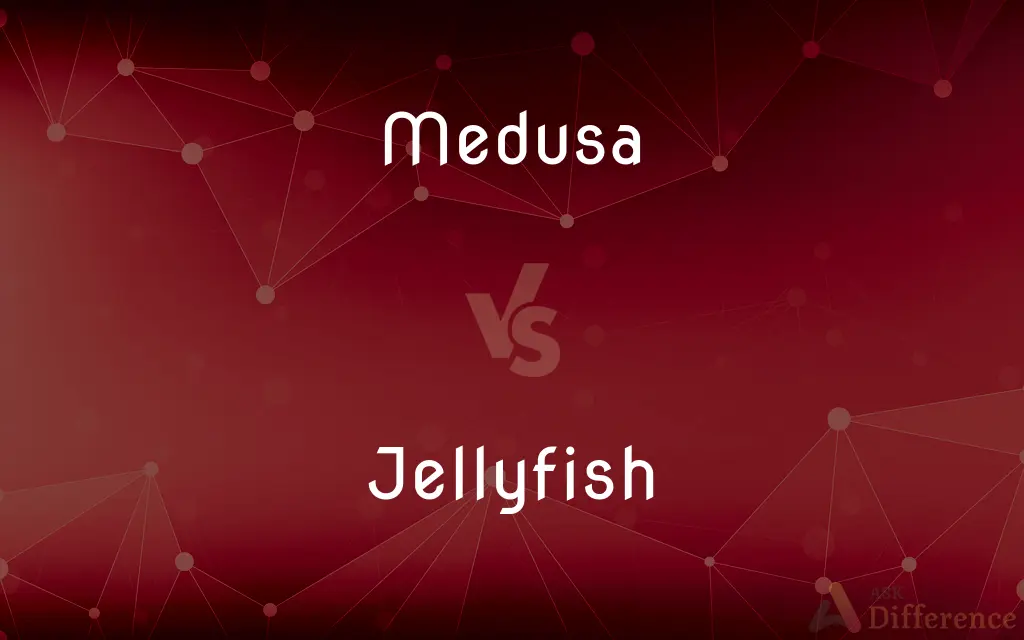Medusa vs. Jellyfish — What's the Difference?
By Tayyaba Rehman & Fiza Rafique — Updated on May 6, 2024
Medusa refers to a life stage of some jellyfish, characterized by free-swimming and umbrella-shaped bodies, while "jellyfish" encompasses the entire species, including various life stages.

Difference Between Medusa and Jellyfish
Table of Contents
ADVERTISEMENT
Key Differences
Medusa is a term used specifically to describe a life stage in the development of certain jellyfish and other members of the phylum Cnidaria, characterized by their free-swimming, bell-shaped bodies, and tentacles that hang downwards. Jellyfish, on the other hand, refers to the entire marine animal known for its gelatinous, often transparent body and tentacles, encompassing all stages of its life cycle, from polyp to medusa.
Medusas are known for their ability to move through the water by pulsations of their umbrella-like bodies, allowing them to migrate, feed, and avoid predators. This locomotion distinguishes the medusa stage from the polyp stage of jellyfish, which cannot move independently. Jellyfish, in their broader classification, include species that may spend more time in one life stage than another, depending on environmental conditions.
The appearance of medusas can vary significantly, from small and barely visible to the naked eye to those with diameters larger than a human. Jellyfish as a whole exhibit a wide range of sizes, colors, and shapes, influenced by their species, habitat, and stage in the life cycle. This diversity reflects the adaptability of jellyfish to different marine environments.
Both medusas and jellyfish play important roles in the marine ecosystem, serving as prey for a variety of marine animals and, in turn, preying on zooplankton and smaller fish. The distinction between medusa and jellyfish highlights the complexity of jellyfish life cycles and the diversity within the Cnidaria phylum.
Comparison Chart
Definition
A life stage of jellyfish, characterized by a free-swimming, bell-shaped body.
A marine animal known for its gelatinous body and tentacles, covering all life stages.
ADVERTISEMENT
Life Cycle Stage
Mature, free-swimming stage.
Encompasses all life stages, including polyp and medusa.
Locomotion
Propels itself by pulsating its bell-shaped body.
Depends on the life stage; medusas are free-swimming, polyps are sessile.
Reproduction
Reproduction occurs during this stage.
Includes both reproduction.
Appearance and Size
Can vary significantly, often umbrella-shaped with tentacles.
Varies widely across different species and life stages.
Compare with Definitions
Medusa
A free-swimming stage in the life cycle of certain jellyfish, characterized by an umbrella-shaped body.
The scientist observed the medusa phase of the jellyfish, noting its graceful movements.
Jellyfish
Marine animals with gelatinous bodies and tentacles, encompassing several life stages.
Jellyfish are often seen floating near the ocean's surface, their tentacles trailing behind.
Medusa
Serve as a crucial part of marine food webs, preying on smaller organisms and providing food for larger predators.
Medusas play a key role in the ocean's ecosystems, maintaining the balance of marine life.
Jellyfish
Found in oceans worldwide, from deep sea to shallow coastal waters.
Jellyfish inhabit every ocean, adapting to a wide range of environmental conditions.
Medusa
Medusas are recognized by their bell-shaped bodies and hanging tentacles.
The medusa's translucent body shimmered in the sunlight, revealing its intricate tentacle structure.
Jellyfish
Exhibits a wide variety of sizes, shapes, and colors across different species.
From the tiny irukandji to the giant lion's mane, jellyfish diversity is astonishing.
Medusa
In Greek mythology, Medusa (; Ancient Greek: Μέδουσα "guardian, protectress") also called Gorgo, was one of the three monstrous Gorgons, generally described as winged human females with living venomous snakes in place of hair. Those who gazed into her eyes would turn to stone.
Jellyfish
Can be both a subject of scientific interest and a hazard due to their stings.
While jellyfish are fascinating to study, their stings can pose risks to swimmers and fishermen.
Medusa
The Gorgon who was killed by Perseus.
Jellyfish
Jellyfish and sea jellies are the informal common names given to the medusa-phase of certain gelatinous members of the subphylum Medusozoa, a major part of the phylum Cnidaria. Jellyfish are mainly free-swimming marine animals with umbrella-shaped bells and trailing tentacles, although a few are anchored to the seabed by stalks rather than being mobile.
Medusa
(zoology) A jellyfish; specifically, a non-polyp form of individual cnidarians, consisting of a gelatinous umbrella-shaped bell and trailing tentacles.
Jellyfish
Any of numerous usually free-swimming marine cnidarians of the class Scyphozoa, characteristically having a gelatinous, tentacled, often bell-shaped medusa stage as the dominant phase of its life cycle. Also called true jellyfish.
Medusa
(pathology) worm-star
Jellyfish
Any of various similar or related cnidarians.
Medusa
The Gorgon; or one of the Gorgons whose hair was changed into serpents, after which all who looked upon her were turned into stone.
Jellyfish
(Informal) One who lacks force of character; a weakling.
Medusa
Any free swimming acaleph; a jellyfish.
Jellyfish
An almost transparent aquatic animal; any one of the acalephs, especially one of the larger species, having a jellylike appearance.
Medusa
(Greek mythology) a woman transformed into a Gorgon by Athena; she was slain by Perseus
Jellyfish
A cnidarian, a member of the phylum Cnidaria.
Jellyfish
A ctenophore, a member of the phylum Ctenophora (the comb jellies).
Jellyfish
A sudoku technique involving possible cell locations for a digit, or pair, or triple, in uniquely four rows and four columns only. This allows for the elimination of candidates around the grid.
Jellyfish
Any one of the acalephs, esp. one of the larger species, having a jellylike appearance. See Medusa and acaleph.
Jellyfish
Large siphonophore having a bladderlike float and stinging tentacles
Common Curiosities
What environments do jellyfish thrive in?
Jellyfish are versatile creatures that can be found in a wide range of marine environments, from the deep sea to surface waters, and from the tropics to the Arctic.
Do jellyfish have brains?
No, jellyfish do not have brains. They have a simple nervous system called a "nerve net" that allows them to respond to environmental stimuli.
How can I treat a jellyfish sting?
Treatment for a jellyfish sting typically involves rinsing the area with vinegar to neutralize the venom, removing tentacles with fine tweezers, and applying heat or cold to alleviate pain.
What is the significance of the medusa stage in a jellyfish's life?
The medusa stage is crucial for the reproductive cycle of jellyfish, allowing them to spread their genes by releasing eggs and sperm into the water.
Can jellyfish be kept in aquariums?
Yes, jellyfish can be kept in specially designed aquariums that ensure constant water movement, mimicking their natural oceanic habitat.
Why do jellyfish sting?
Jellyfish sting as a defense mechanism and to capture prey. Their tentacles contain specialized cells called cnidocytes, which release venom when triggered.
How long do jellyfish live?
The lifespan of a jellyfish can vary widely depending on the species. Some may live for a few days to weeks in the medusa stage, while others, like the immortal jellyfish (Turritopsis dohrnii), can theoretically live forever under the right conditions by reverting to their polyp stage.
What do jellyfish eat?
Jellyfish are primarily carnivorous, feeding on small fish, zooplankton, and sometimes other jellyfish. They use their tentacles to ensnare and paralyze their prey.
Do jellyfish have any predators?
Yes, jellyfish have several natural predators, including sea turtles, certain species of fish (like sunfish), and even other jellyfish species.
Are all jellyfish transparent?
While many jellyfish are transparent or semi-transparent, allowing them to blend into their watery environments, there are also species with vibrant colors, including blue, pink, and purple.
Can jellyfish feel pain?
Due to their simple nervous systems, scientists believe that jellyfish do not feel pain in the way humans or other animals with more complex nervous systems do.
What role do jellyfish play in the ecosystem?
Jellyfish play vital roles in marine ecosystems, including controlling prey populations, providing food for predators, and even contributing to the carbon cycle through their biomass.
How do jellyfish move?
Jellyfish move by contracting and relaxing their bell-shaped bodies, propelling themselves through the water. This movement is more prominent in the medusa stage.
What happens to jellyfish in the winter?
In colder climates, some jellyfish species can enter a dormant state or their polyps can survive winter conditions, resuming activity or releasing medusas when temperatures rise.
What is jellyfish bloom and why does it happen?
A jellyfish bloom refers to a rapid increase in jellyfish population in an area, often caused by factors such as ocean currents, overfishing of predators, and changes in sea temperature or salinity.
Share Your Discovery

Previous Comparison
Error vs. Glitch
Next Comparison
Nightmare vs. DaymareAuthor Spotlight
Written by
Tayyaba RehmanTayyaba Rehman is a distinguished writer, currently serving as a primary contributor to askdifference.com. As a researcher in semantics and etymology, Tayyaba's passion for the complexity of languages and their distinctions has found a perfect home on the platform. Tayyaba delves into the intricacies of language, distinguishing between commonly confused words and phrases, thereby providing clarity for readers worldwide.
Co-written by
Fiza RafiqueFiza Rafique is a skilled content writer at AskDifference.com, where she meticulously refines and enhances written pieces. Drawing from her vast editorial expertise, Fiza ensures clarity, accuracy, and precision in every article. Passionate about language, she continually seeks to elevate the quality of content for readers worldwide.
















































